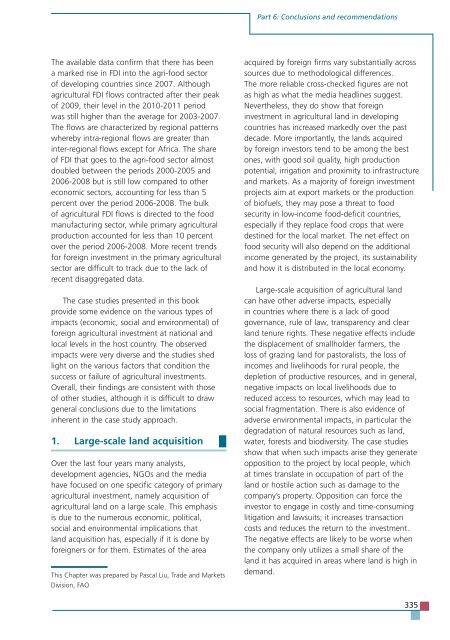TRENDS AND IMPACTS OF FOREIGN INVESTMENT IN DEVELOPING COUNTRY AGRICULTURE
TRENDS AND IMPACTS OF FOREIGN INVESTMENT IN DEVELOPING COUNTRY AGRICULTURE
TRENDS AND IMPACTS OF FOREIGN INVESTMENT IN DEVELOPING COUNTRY AGRICULTURE
Create successful ePaper yourself
Turn your PDF publications into a flip-book with our unique Google optimized e-Paper software.
The available data confirm that there has been<br />
a marked rise in FDI into the agri-food sector<br />
of developing countries since 2007. Although<br />
agricultural FDI flows contracted after their peak<br />
of 2009, their level in the 2010-2011 period<br />
was still higher than the average for 2003-2007.<br />
The flows are characterized by regional patterns<br />
whereby intra-regional flows are greater than<br />
inter-regional flows except for Africa. The share<br />
of FDI that goes to the agri-food sector almost<br />
doubled between the periods 2000-2005 and<br />
2006-2008 but is still low compared to other<br />
economic sectors, accounting for less than 5<br />
percent over the period 2006-2008. The bulk<br />
of agricultural FDI flows is directed to the food<br />
manufacturing sector, while primary agricultural<br />
production accounted for less than 10 percent<br />
over the period 2006-2008. More recent trends<br />
for foreign investment in the primary agricultural<br />
sector are difficult to track due to the lack of<br />
recent disaggregated data.<br />
The case studies presented in this book<br />
provide some evidence on the various types of<br />
impacts (economic, social and environmental) of<br />
foreign agricultural investment at national and<br />
local levels in the host country. The observed<br />
impacts were very diverse and the studies shed<br />
light on the various factors that condition the<br />
success or failure of agricultural investments.<br />
Overall, their findings are consistent with those<br />
of other studies, although it is difficult to draw<br />
general conclusions due to the limitations<br />
inherent in the case study approach.<br />
1. Large-scale land acquisition <br />
Over the last four years many analysts,<br />
development agencies, NGOs and the media<br />
have focused on one specific category of primary<br />
agricultural investment, namely acquisition of<br />
agricultural land on a large scale. This emphasis<br />
is due to the numerous economic, political,<br />
social and environmental implications that<br />
land acquisition has, especially if it is done by<br />
foreigners or for them. Estimates of the area<br />
This Chapter was prepared by Pascal Liu, Trade and Markets<br />
Division, FAO<br />
Part 6: Conclusions and recommendations<br />
acquired by foreign firms vary substantially across<br />
sources due to methodological differences.<br />
The more reliable cross-checked figures are not<br />
as high as what the media headlines suggest.<br />
Nevertheless, they do show that foreign<br />
investment in agricultural land in developing<br />
countries has increased markedly over the past<br />
decade. More importantly, the lands acquired<br />
by foreign investors tend to be among the best<br />
ones, with good soil quality, high production<br />
potential, irrigation and proximity to infrastructure<br />
and markets. As a majority of foreign investment<br />
projects aim at export markets or the production<br />
of biofuels, they may pose a threat to food<br />
security in low-income food-deficit countries,<br />
especially if they replace food crops that were<br />
destined for the local market. The net effect on<br />
food security will also depend on the additional<br />
income generated by the project, its sustainability<br />
and how it is distributed in the local economy.<br />
Large-scale acquisition of agricultural land<br />
can have other adverse impacts, especially<br />
in countries where there is a lack of good<br />
governance, rule of law, transparency and clear<br />
land tenure rights. These negative effects include<br />
the displacement of smallholder farmers, the<br />
loss of grazing land for pastoralists, the loss of<br />
incomes and livelihoods for rural people, the<br />
depletion of productive resources, and in general,<br />
negative impacts on local livelihoods due to<br />
reduced access to resources, which may lead to<br />
social fragmentation. There is also evidence of<br />
adverse environmental impacts, in particular the<br />
degradation of natural resources such as land,<br />
water, forests and biodiversity. The case studies<br />
show that when such impacts arise they generate<br />
opposition to the project by local people, which<br />
at times translate in occupation of part of the<br />
land or hostile action such as damage to the<br />
company’s property. Opposition can force the<br />
investor to engage in costly and time-consuming<br />
litigation and lawsuits; it increases transaction<br />
costs and reduces the return to the investment.<br />
The negative effects are likely to be worse when<br />
the company only utilizes a small share of the<br />
land it has acquired in areas where land is high in<br />
demand.<br />
335


